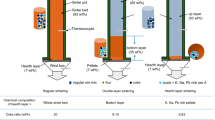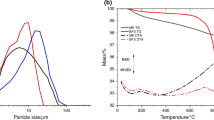Abstract
The influence of boron oxide B2O3 and the basicity of CaO–SiO2–B2O3–Al2O3 slag on the saturation concentration of magnesium oxide MgO is studied by means of simplex experiment-design lattices. That permits the formulation of mathematical models describing the dependence of the specific property on the composition in the form of a continuous function. Synthetic slags corresponding in composition to the vertices of the given simplex are produced in graphite crucibles from preroasted analytically pure oxides. The slag compositions corresponding to the other points of the local simplex design are obtained by cross-mixing of the slags at the vertices. The experimental data provide the basis for mathematical models describing the influence of the slag composition on the saturation concentration of magnesium oxide MgO. The results of mathematical modeling are presented as a graph of the slag composition against the saturation concentration of magnesium oxide MgO. By analysis of the results, new information is obtained regarding the influence of the boron oxide and the basicity of CaO–SiO2–B2O3–Al2O3 slag on the saturation concentration of magnesium oxide MgO. It is found that, for slags formed in regions of basicity 2—3 with 1–3% B2O3, the saturation concentration of magnesium oxide MgO varies from 3 to 9%. Increase in the B2O3 content to 4% increases the saturation concentration of magnesium oxide MgO to 11–13%. Switching to slags of basicity 3–4 lowers the saturation concentration of magnesium oxide MgO to 2–5% with 1–3% B2O3 and to 7–9% with 3–4% B2O3 in the slag. Slag formation in the region of basicity 4–5 with 1–3% B2O3 does not significantly decrease the saturation concentration of magnesium oxide in the slag. In this basicity range, the saturation concentration of magnesium oxide MgO in the slag varies from 2 to 4% and hardly reaches 7% with increase in B2O3 content to 4%. In that case, the cost of the steel rises, on account of the increase in the consumption of lime and the material containing B2O3.


Similar content being viewed by others
REFERENCES
Dyudkin, D.A. and Kisilenko, V.V., Proizvodstvo stali. Tom 1. Protsessy vyplavki, vnepechnoi obrabotki i nepreryvnoi razlivki (Steel Production, Vol. 1: Smelting, Out-of-Furnace Processing, and Continuous Casting), Moscow: Teplotekhnik, 2008.
Jönsson, P.G. and Jonsson, L.T.I., The use of fundamental process models in studying ladle refining operations, ISIJ Int., 2001, vol. 41, no. 11, pp. 1289–1302.
Yan, P., Guo, X., Huang, S., Dyck, J., Guo, M., and Blanpain, B., Desulphurisation of stainless steel by using CaO–Al2O3 based slags during secondary metallurgy, ISIJ Int., 2013, vol. 53, no. 3, pp. 459–467.
Nurhudin, Hidayat, M., and Basuki, W., Deep desulfurization process for producing ultra-low sulfur steel at PT Krakatau Steel, SEAISI Q. J., 2004, vol. 33, no. 2, pp. 29–34.
Takahashi, D., Kamo, M., Kurose, Y., and Nomura, H., Deep steel desulphurization technology in ladle furnace at KSC, Ironmaking Steelmaking, 2003, vol. 30, no. 2, pp. 116–119.
Suito, H. and Inoue, R., Dissolution behavior and stabilization of fluorine in secondary refining slags, ISIJ Int., 2002, vol. 42, no. 8, pp. 921–929.
Iwamasa, P.K. and Fruehan, R.J. Formation and behavior of Mn containing oxysulphide inclusions during desulphurization, deoxidation, and alloying, Metall. Mater. Trans. B, 1997, no. 28, p. 47.
Wang, H., Zhang, T., Zhu, H., Li, G., Yan, Y., and Wang, J., Effect of B2O3 on melting temperature, viscosity and desulfurization capacity of CaO-based refining flux, ISIJ Int., 2011, vol. 51, no. 5, pp. 702–708.
Gaye, H. and Lehmann, J., Modeling and prediction of reactions involving metals, slags and fluxes, VII Int. Conf. on Molten Slags Fluxes and Salts, Johannesburg: South Afr. Inst. Min. Metall., 2004. pp. 619–624.
Ko, K.Y. and Park, J.H., Effect of CaF2 addition on the viscosity and structure of CaO–SiO2–MnO slags, ISIJ Int., 2013, vol. 53, no. 6, pp. 958–965.
Sokolov, G.A., Vnepechnoe rafinirovanie stali (Out-of-Furnace Steel Refining), Moscow: Metallurgiya, 1977.
Starikov, V.S., Temlyantsev, M.V., and Starikov, V.V., Ogneupory i futerovki v kovshevoi metallurgii (Refractories and Linings in Ladle Metallurgy), Moscow: Mosk. Inst. Stali Splavov, 2003.
Kashcheev, I.D., Svoistva i primenenie ogneuporov. Spravochnoe izdanie (Properties and Application of Refractories: Handbook), Moscow: Teplotekhnik, 2004.
Khoroshavin, L.B., Perepelitsin, V.A., and Kokonov, V.A., Magnezial’nye ogneupory (Magnesia Refractories), Moscow: Intermet Inzhiniring, 2001.
Shyurman, E., Mann, G., Nole, D., et al., Effect of dissolved MgO on stability of dolomite lining of oxygen converters, Chern. Met., 1985, no. 3, pp. 33–41.
Popel’, S.I., Sotnikov, A.I., and Boronenkov, V.N., Teoriya metallurgicheskikh protsessov (Theory of Metallurgical Processes), Moscow: Metallurgiya, 1986.
Wang, H.-M., Li, G.-R., Dai, Q.-X., Li, B., Zhang, X.-J., and Shi, G.-M., CAS-OB refining: slag modification with B2O3–CaO and CaF2–CaO, Ironmaking Steelmaking, 2007, vol. 34, no. 4, pp. 350–353.
Babenko, A.A., Istomin, S.A., Protopopov, E.V., Sychev, A.V., and Ryabov, V.V., Viscosity of CaO–SiO2–Al2O3–MgO–B2O3 slags, Steel Transl., 2014, vol. 44, no. 2, pp. 110–112.
Kim, V.A., Nikolai, E.I., Akberdin, A.A., and Kulikov, I.S., Planirovanie eksperimenta pri issledovanii fiziko-khimicheskikh svoistv metallurgicheskikh shlakov: metodicheskoe posobie (Experiment Planning in Study of Physical-Chemical Properties of Metallurgical Slags: Manual), Alma-Ata: Nauka, 1989.
Babenko, A.A., Zhuchkov, V.I., Smirnov, L.A., et al., Application of the method of simplex lattices to construct composition-viscosity diagrams of slags of CaO–SiO2–Al2O3–MgO–B2O3 system, Butlerovskie Soobshch., 2016, vol. 48, no. 11, pp. 40–44.
ACKNOWLEDGMENTS
Financial support was provided by the Russian Science Fund (project no. 16-19-10435).
Author information
Authors and Affiliations
Corresponding authors
Additional information
Translated by Bernard Gilbert
About this article
Cite this article
Babenko, A.A., Smetannikov, A.N., Zhuchkov, V.I. et al. Influence of B2O3 and Basicity of CaO–SiO2–B2O3–Al2O3 Slag on the Saturation Concentration of Magnesium Oxide. Steel Transl. 49, 87–90 (2019). https://doi.org/10.3103/S0967091219020037
Received:
Revised:
Accepted:
Published:
Issue Date:
DOI: https://doi.org/10.3103/S0967091219020037




